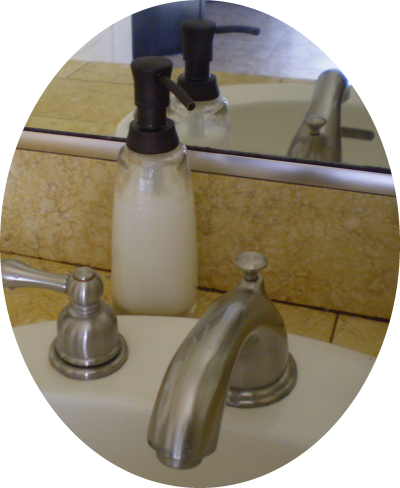Natural Year Challenge: Household - Month Ten
Make Liquid  Soap
Soap
Welcome to the final month of our Natural Year Challenge! Whether you have taken big steps or small, no doubt you've experienced some of the many rewards of more natural, less toxic living. We hope this series has inspired you to continue the journey!
Our last step together involves making all-natural liquid soap. If this process seems overwhelming, consider making your own liquid soap by simply grating castile soap and mixing with boiling water (see our Month Three Household Challenge: Make Household Soaps). But if you're adventurous and want to give this a try, we think you'll be surprised by how simple soapmaking really is! There are a myriad of uses for liquid soap, which makes the effort well worth your time investment.
True liquid soap uses potassium hydroxide rather than sodium hydroxide. Potassium hydroxide creates long strands as opposed to sodium hydroxide's crystalline structures, so the soap mixture remains fluid and the end product remains clear. Caution is required when using either. If this is your first attempt, Cranberry Lane offers an excellent guide on basic soapmaking.
Supplies needed:
- Slow cooker
- Immersion blender
- Coconut oil
- Castor oil
- Filtered water
- pH strips or phenolphthalein
- Safety goggles and gloves
Recipe:
The following recipe is adapted from The Everything Soapmaking Book by Alicia Grosso.
- 22 oz. coconut oil
- 4 oz. castor oil
- 1 oz. jojoba oil
- 16 oz. distilled water
- 6.25 oz. potassium hydroxide (Bramble Berry is one recommended source)
- Turn slow cooker to low setting. Place oils in the slow cooker. Cover and melt the oils.
- Place water in heatproof container. Wearing appropriate safety gear, sprinkle potassium hydroxide into water. Stir until dissolved.
- Add the hydroxide/water mix to the slow cooker. (Use extra caution to avoid splattering.)
- Blend the mixture with an immersion blender. You will be watching for the mixture to thicken. This is called "trace" and it will happen suddenly, but may take up to 20 minutes to occur.
- Allow the paste to cook for 3 hours until it becomes translucent. Stir to neutralize every 30-60 minutes. Keep the slow cooker covered tightly, except for the brief stirring.
- Test for neutrality, using pH strips or 2 drops of phenolphthalein. See Testing Your Soap pH Level at the Soap Made Easy website for more information.
Store the liquid paste in the refrigerator and scoop out to make liquid soap as needed. Boil 1 part paste with 1 part water and allow to simmer until dissolved.
Use your liquid soap for shampoos, hand soap, dish soap, even laundry soap! Proportions will vary; for example, foaming liquid soap requires less soap than pump dispensers.
Have fun using this pure, all-natural soap made with your very own hands!
Making your own liquid soap is easier than it seems! Join Andrea as she demonstrates the process of combining potassium hydroxide with healthy oils to make a versatile liquid soap.

